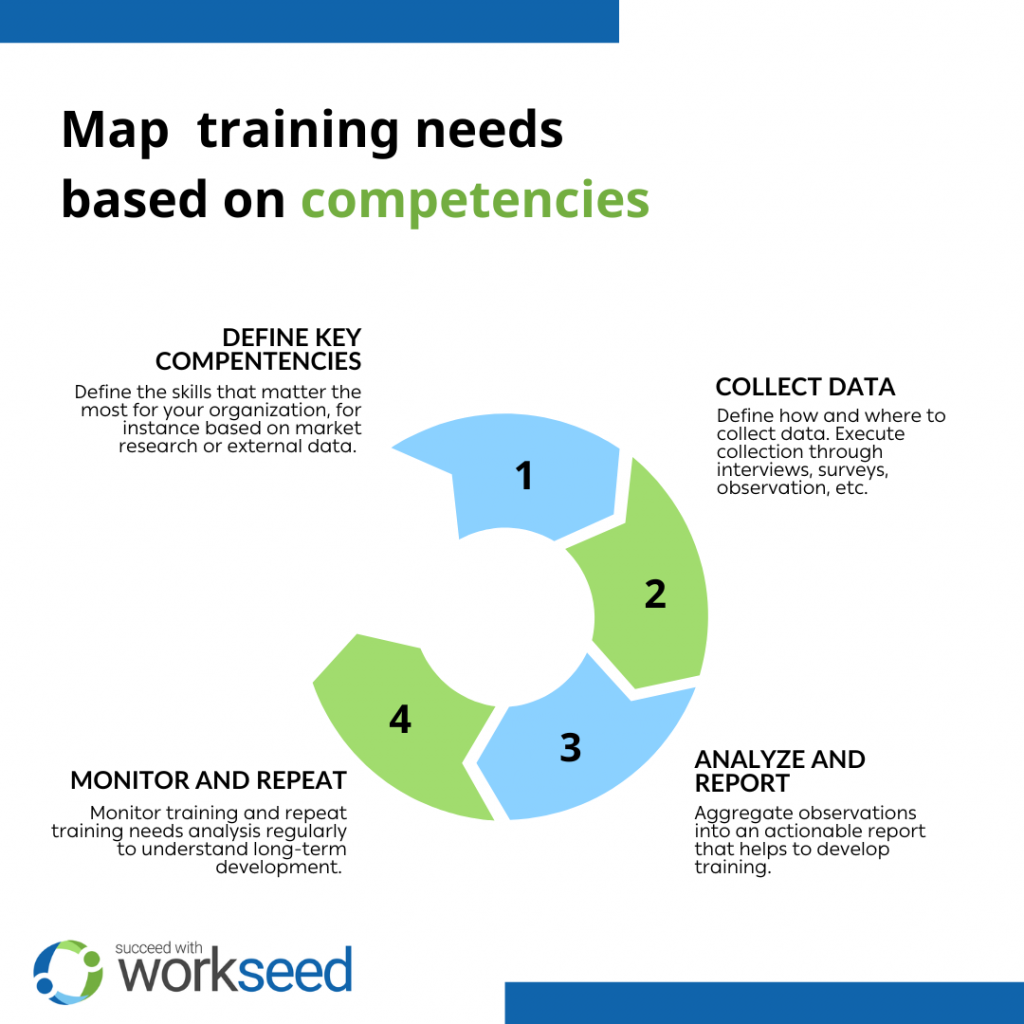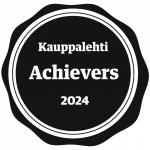Corporate training and development should be designed based on strategy. When the HR department has a good understanding of what it wants to achieve by providing training opportunities, training modules can be designed purposefully.
Understanding training needs requires systematic and regular mapping. Training needs analysis is a tool for companies to systematically review their current situation and identify concrete areas of development that can be addressed through training. It allows the HR to design goal-oriented interventions and develop training programs.
There are several tools and frameworks for training needs analysis. In this articles we introduce the basic principles of competency oriented training needs analysis.

Why competency oriented training needs analysis
Competency based analysis identifies discrepancies between existing and desired skills and competencies among the staff. When the organization understands its current situation and what it wants to achieve, concrete decisions can be made.
Analysis based on key competencies has several benefits:
It provides concrete help. Competencies can be defined very clearly and in concrete terms. It provides human resources an unambiguous roadmap for designing training programs and clear tools for managing competencies. Mapping serves as a good starting point for planning training and certification programs.
It is not time-bound. Mapping can be executed any time. It is not bound to any specific project, season, or quarter. It provides a realistic cross-sectional impression of existing skills. It is also easy to execute regularly to understand how training needs develop.
It fits all organizations. Competency based analysis is a flexible tool that can be adapted to organizations of different sizes. Micro enterprises with a handful of employees as well as multinational corporations can execute some form of needs analysis.
It can exploit different research methods. Mapping training needs can make the most of different research methods. Smaller organizations can use qualitative research for rich data, but larger organizations can also benefit from mixed method or quantitative surveys.
Steps in a training needs analysis
In different organizations training needs analysis can look very different. Whatever the needs, the analysis should be systematic and oriented to results, taking context and restrictions into consideration.
Define key competencies and goals
Particularly if the organization has not performed a training needs analysis before, defining key skills is the first phase of the analysis. Human resources should understand what the organization wants to achieve and define clear competencies that are necessary to achieve them. These competencies should be critical for business operations and support long-term viability of the operations.
In many cases defining the key competencies is a separate analytical process that involves multiple stakeholders across the organization, beyond human resources. Often it is useful to define organization level and department specific competencies. This helps to keep the key competencies grounded and concrete.
It is also important to understand long-term needs. These help to frame the results of any specific iteration of training needs analysis into a broader context.
Levels of training needs analysis
The analysis itself can be executed on multiple levels of an organization, such as:
Entire organization. Mapping on the level of the organization helps to establish a holistic overview of the company’s current situation. This can help management to understand broad trends and design general interventions. Analyzing the entire organization can be useful for smaller companies or companies that are executing their first training needs analysis.
Departments or functional areas. Specifying the training needs analysis to specific departments or areas helps to provide richer, more detailed data that is more relevant for grassroots level development. It can also help to map the particular needs of different functional areas.
Individuals and tasks. It is also possible to analyze the needs of particular positions or even individual employees. This level of analysis helps to understand very concrete areas of improvement and identity problems. It can also support personal career planning or coaching, but may have limited impact on developing training programs.
Data collection for analysis
Many methods for data collection are available for training needs analysis. Different methods should be used in combination for best effect. Some common methods of data collection are:
Career development conversations. Many companies regularly perform development conversations with individual employees. These are an excellent opportunity to collect rich and detailed feedback with relatively little extra input. They can provide organizations with detailed qualitative insights that would be difficult to acquire through questionnaires or an LMS.
Questionnaires. Standardized questionnaires are a flexible tool for data collection that scales well to any organization. They can be easily distributed online and be used to collect quantitative or qualitative data.
Focus groups. Interviews in groups can be effective ways to collect qualitative insights on social interactions. Focus groups can be used to brainstorm new ideas or collect feedback on existing initiatives. They can be expensive to organize, however.
Observation. Human resources and middle management can participate in data collection by documenting their own observations on the field. Often people coordinating work on the level of teams or departments have the best understanding of what is happening under them. Observation provides rich data that guides decision making and analyses.
Internal databases. All modern companies use multiple information systems that can be leveraged to collect quantitative data on competencies. Different HR management tools likely provide data on skills that the staff has accumulated through training or work. If the organization uses a learning management system, it can be used to collect data on training impact. There might also already be a certification system that makes it possible to keep track of training programs.
External sources. Companies can also use external data and research for defining training needs. Reports and data provided by industry or research organizations can be invaluable for understanding the market where the company operates.
Analysis and execution
The final product of the training needs analysis is a report that presents the current state of competencies and skills in the organization. This report can be benchmarked against a theoretical optimal state of competencies as defined by market research or management’s vision.
Report informs plans to close competency gaps and assess training development. When developing corporate training based on a training needs analysis, it is necessary to transparently assess its impact and re-analyze training needs regularly. Training program is not a set-and-forget initiative. It should be iteratively updated as the organization and its needs evolve.
Learning management system as an analytics tool
A learning management system (LMS) facilitates the workflow of corporate training, from planning to monitoring. A comprehensive LMS can manage every step of training, including content production, teaching, monitoring learner progress, identifying quality issues, identifying learner problems, and assessing training program impact. It produces qualitative and quantitative data on learners and contents, which help assessing quality.
Workseed LMS is a working life-oriented tool that is particularly suitable for competency based corporate training. It makes both managing and developing learning simple for HR. Workseed allows creating key skills and basing training modules on them. Training needs analysis can thus inform the content creation.
Workseed also includes tools for automatically generating certificates based on passed study modules and transparently managing formal competencies. This helps to make managing competencies transparent for daily operations as well as HR audits.
You can read more in detail about certificates and formal competencies here.
Want to know more about Workseed?
In case you want to know how Workseed can improve training and development in your business, feel free to book a demo with our experts here. We can help you map areas of improvement and present convincing use cases.
In case you are already considering an LMS for your business, we recommend you take a look at our tips on choosing a learning management system based on user needs.














